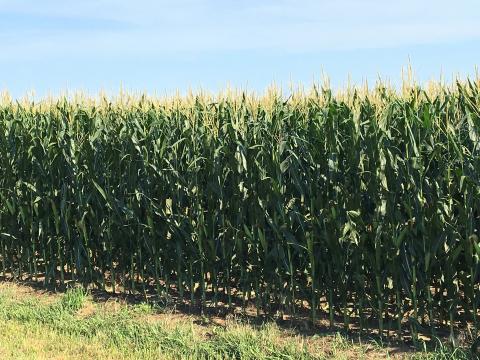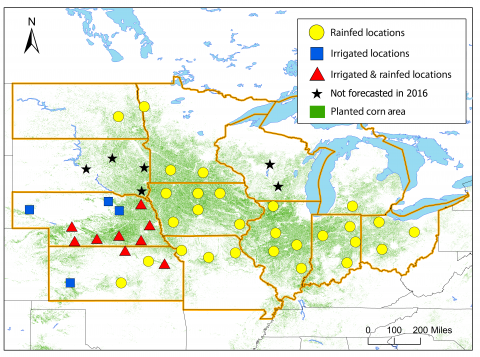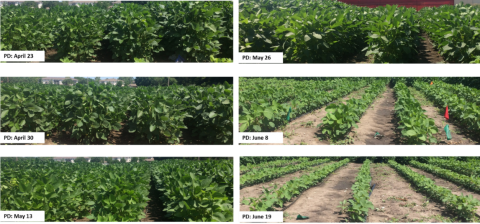2016 Corn Yield Forecasts as of July 27
July 28, 2016
Corn yield forecasts, based on Hybrid-Maize simulations and input from crop experts in 10 states, were developed for 41 sites across the Corn Belt on July 27. For irrigated corn, based on this conditions at this point in the season, there is only a low probability of below average yields. For rainfed corn, the majority of the sites studied, the results are more variable across locations. The article includes yield forecasts for each site, along with conditions for the period contributing to the forecasts.
2016 Corn Yield Forecasts as of July 13
July 14, 2016
Based on modeling corn growth stage and end-of-season yield for 41 sites in 10 Corn Belt states, researchers are forecasting potential end-of-season yield in "real time" to aid in decision-making thoughout the season. On July 14 they reported that corn has already reached or is approaching silking throughout most of Nebraska and the Corn Belt, except for corn in the northern and eastern states, where growth is running behind the rest of the region.based on modeling end-of-season corn yield for 41 sites. There is a low (<20%) probability of below-average yields at all irrigated locations, except for two sites in southeastern Nebraska. The range of forecast yields at the rainfed sites is wider. There is a relatively high probability (>75%) of above-average yield at two locations in the northern states and below-average yield at three locations. See story for predicted yields and probabilities for all the sites.
2016 Corn Yield Forecasts: Approach and Interpretation of Results
June 30, 2016
The Yield Forecasting Center will be providing in-season corn yield forecasts every two weeks starting in mid-July to aid growers and the ag industry in making management, logistics, and marketing decisions through the season. The Center consists of a core team at UNL in collaboration with agronomists and extension educators from universities throughout the Corn Belt.
Early Bird Gets the Worm: Benefits of Early Soybean Planting
April 20, 2016
Weather during the growing season (sunlight, temperature, and rainfall) will ultimately determine the soybean yield potential in a given year. While it is difficult to predict the weather ahead, you have an opportunity to manage your planting date to increase the odds of achieving a higher yield in 2016.
Soybean Seeding Rate Tips
April 20, 2016
Numerous soybean seeding rate studies have indicated that a final plant population of about 80,000 to 120,000 plants per acre is likely sufficient for ensuring an economic return, with the latter being based on weighing the slightly higher yield potential with higher final pl
Three Key Considerations for Planting Corn and Soybeans
April 15, 2016
Planting as early as possible allows your crop to collect solar radiation sooner; however, the practice comes with some risks which need to be weighed against the benefit.





